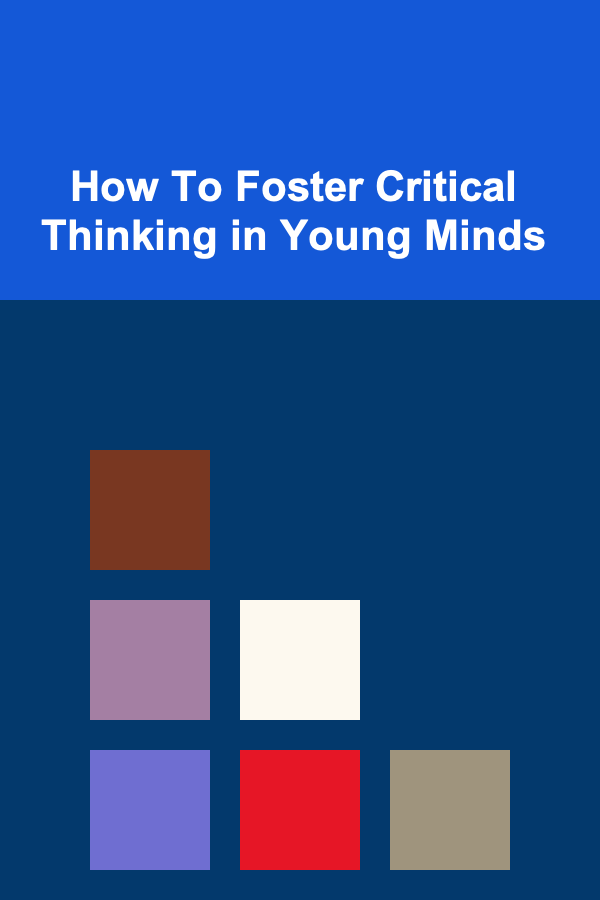
How To Foster Critical Thinking in Young Minds
ebook include PDF & Audio bundle (Micro Guide)
$12.99$5.99
Limited Time Offer! Order within the next:

Critical thinking is the foundation for problem-solving, decision-making, and creative thinking. It is a skill that transcends subject matter, equipping individuals to navigate a complex world. In today's rapidly changing society, fostering critical thinking in young minds is more important than ever. As we prepare future generations for challenges that we cannot yet fully anticipate, empowering them with the ability to think critically will enable them to analyze information, evaluate alternatives, and make informed decisions.
This article delves into how to foster critical thinking in young minds, addressing its significance, core components, methods, and practical strategies to instill it in children and adolescents. From creating an environment conducive to open-minded inquiry to teaching specific techniques, there are various ways educators, parents, and mentors can nurture the intellectual curiosity and cognitive abilities of young individuals.
The Importance of Critical Thinking in a Modern World
Critical thinking is the ability to think clearly and rationally, understanding the logical connection between ideas. It allows individuals to:
- Analyze Information: In an age where information is abundant and constantly changing, critical thinking enables individuals to sift through facts, opinions, and biases to find the truth.
- Evaluate Perspectives: It fosters the ability to consider diverse viewpoints, assess their validity, and make balanced decisions.
- Solve Problems Creatively: By thinking critically, one can devise innovative solutions to challenges, which is crucial in a rapidly evolving job market.
- Promote Independent Thinking: Critical thinkers are more likely to challenge conventional wisdom, question assumptions, and approach problems from fresh angles.
Fostering critical thinking in young minds ensures that they are not passive consumers of information but active thinkers who can engage with the world on their terms.
Core Components of Critical Thinking
Before diving into strategies for fostering critical thinking, it is essential to understand the components that make up the critical thinking process. These include:
1. Analysis
The ability to break down complex ideas or problems into smaller, more manageable components. This involves identifying key concepts, relationships, and structures.
2. Evaluation
Critical thinkers evaluate the credibility of information, assessing sources, evidence, and reasoning. This is essential when making decisions or forming opinions based on data.
3. Inference
Inference involves drawing logical conclusions from available information, even when some facts are unknown. It requires the thinker to fill in gaps by reasoning and applying prior knowledge.
4. Interpretation
Interpreting means understanding the meaning of information, including recognizing underlying assumptions, recognizing patterns, and appreciating nuances in communication.
5. Reasoning
Reasoning is the backbone of critical thinking, enabling individuals to connect ideas logically and make sense of complex situations. It includes both deductive and inductive reasoning.
6. Problem-Solving
Critical thinking is closely tied to effective problem-solving. Young thinkers should learn to approach problems systematically and evaluate possible solutions before taking action.
7. Reflection
Reflection allows individuals to assess their thinking process. It is an essential tool for self-improvement and understanding biases, assumptions, and areas where further learning is needed.
How to Foster Critical Thinking in Young Minds
1. Encourage Curiosity
Curiosity is the first step toward critical thinking. Children who are curious about the world around them are more likely to ask questions, seek answers, and challenge existing knowledge. Encouraging curiosity involves creating an environment where asking questions is celebrated, not discouraged.
- Ask Open-Ended Questions: Instead of asking yes-or-no questions, ask questions that prompt deeper thinking. For instance, "What do you think would happen if...?" or "Why do you think this is the case?"
- Foster an Inquisitive Mindset: Support children in exploring subjects they find interesting, even if these topics seem unrelated to their current studies.
- Praise Thoughtful Questions: When children ask insightful questions, acknowledge and encourage their inquisitiveness. This reinforces the value of critical thinking.
2. Teach Problem-Solving Skills
Critical thinking is often practiced through problem-solving. Teach young minds to approach problems with a methodical mindset:
- Break Down Complex Problems: Encourage them to decompose large problems into smaller parts and consider multiple solutions before deciding on the best course of action.
- Emphasize Logical Reasoning: Help children develop the ability to think through problems step-by-step. Provide examples where logical reasoning is essential, such as puzzles, games, or real-life scenarios.
- Challenge Assumptions: Teach children to question their own assumptions. A simple exercise could be asking, "What would happen if your assumption is wrong?" This encourages children to consider alternatives.
3. Promote Open Discussions and Debates
One of the best ways to develop critical thinking is through discussions and debates. Engaging in dialogue forces children to articulate their thoughts, defend their positions, and consider other viewpoints.
- Create Safe Spaces for Debate: Set up opportunities for children to express opinions on various topics. Encourage respectful debate where the goal is to understand differing perspectives rather than win the argument.
- Model Active Listening: Show how to listen actively during discussions. Critical thinking doesn't just involve speaking but also listening, reflecting, and responding thoughtfully.
- Discuss Real-Life Issues: Talk about current events, ethical dilemmas, or even fictional scenarios that require children to weigh different perspectives and think critically.
4. Incorporate Collaborative Learning
Collaborative learning encourages critical thinking by allowing children to work together to solve problems. By engaging in group activities, children can exchange ideas, challenge each other's thinking, and learn from different perspectives.
- Group Projects: Assign tasks that require group collaboration, where members must contribute different skills and ideas. This fosters teamwork and critical thinking as they debate solutions and come to a consensus.
- Peer Teaching: Having children explain concepts to one another forces them to process and organize their knowledge, making their thinking clearer and more structured.
5. Model Critical Thinking
Young minds learn by observing adults, so modeling critical thinking is essential. Show them how you analyze situations, evaluate different perspectives, and make thoughtful decisions.
- Think Aloud: When making decisions or solving problems, verbalize your thought process. Explain how you are weighing evidence, considering alternatives, and drawing conclusions.
- Discuss Mistakes: Share instances where you made mistakes and how you used critical thinking to correct them. This encourages children to view mistakes as learning opportunities, not failures.
6. Encourage Reading and Exposure to Diverse Ideas
Exposure to a variety of ideas, cultures, and perspectives helps young minds develop critical thinking. Reading, in particular, broadens one's worldview, exposes individuals to different writing styles, and encourages analysis of complex ideas.
- Read a Variety of Genres: Encourage children to read books, articles, and stories from a variety of genres and authors. Exposure to diverse content challenges them to think critically about the world around them.
- Discuss What They Read: After reading, engage children in discussions about the material. Ask them to reflect on the motivations of characters, the implications of the plot, or the themes presented.
7. Encourage Reflection
Reflection is an essential tool for developing critical thinking. Children need to think about their thinking processes, what worked, what didn't, and why.
- Journaling: Encourage children to keep a journal where they reflect on their day, problems they encountered, and how they solved them. This promotes self-awareness and critical reflection.
- Ask Reflective Questions: After completing a task or activity, ask children reflective questions such as, "What would you do differently next time?" or "How did you come to this decision?"
8. Use Creative Exercises
Creativity and critical thinking go hand in hand. By encouraging creative thinking, you help young minds develop the flexibility and open-mindedness necessary for critical thought.
- Brainstorming Sessions: Regularly engage in brainstorming sessions where children come up with multiple solutions to a problem. The focus should be on quantity over quality at first, encouraging an open mind to possibilities.
- Problem-Based Learning (PBL): Present children with real-world problems that require creative solutions. For instance, ask them to design a solution to reduce waste or create a plan to improve their school environment.
9. Foster a Growth Mindset
A growth mindset---the belief that intelligence and abilities can be developed---supports critical thinking. Children who believe they can improve their thinking through effort are more likely to engage in deep, reflective thinking.
- Praise Effort, Not Just Results: Focus on praising the process rather than just the outcome. For example, commend the thought process, persistence, and reasoning demonstrated during problem-solving.
- Emphasize the Learning Process: Reinforce that critical thinking is a skill that can be developed and perfected over time. Encourage children to take on challenges and learn from setbacks.
Conclusion
Fostering critical thinking in young minds is essential for their intellectual growth, academic success, and ability to navigate an increasingly complex world. By creating environments that promote curiosity, problem-solving, open discussion, and reflection, educators, parents, and mentors can cultivate a generation of independent thinkers. Critical thinking isn't just a skill---it's a mindset that empowers children to question, analyze, and innovate, paving the way for future generations to thrive in an unpredictable world.

How to Build a Checklist for Regular Maintenance and Safety Inspections
Read More
How to Develop a Content Strategy That Aligns with Your Business Goals
Read More
How to Use Baskets and Trays to Declutter Your Desk
Read More
How To Understand Game Genres and Find Your Niche
Read More
Enhancing Your Brain's Cognitive Flexibility
Read More
How to Analyze Your Monthly Expenses
Read MoreOther Products

How to Build a Checklist for Regular Maintenance and Safety Inspections
Read More
How to Develop a Content Strategy That Aligns with Your Business Goals
Read More
How to Use Baskets and Trays to Declutter Your Desk
Read More
How To Understand Game Genres and Find Your Niche
Read More
Enhancing Your Brain's Cognitive Flexibility
Read More